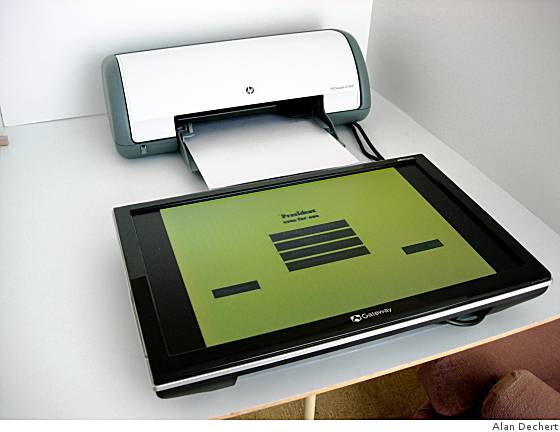Voting machine gets LinuxWorld tryout
Saturday, August 2, 2008
Photo: Designers say this voting machine is more reliable than ones now
in use.
Like many people, Alan Dechert was outraged when the 2000 presidential election was thrown to the Supreme Court because nobody could figure out how Florida's voters had voted.
An engineer who has designed and tested software for a living, he thinks the outcomes of elections should never be in doubt.
So Dechert and a couple of colleagues founded the Open Voting Consortium, a nonprofit group dedicated to delivering "trustable and open voting systems." In addition to lobbying against proprietary voting machines, they have spent the last several years working with scientists and engineers around the world to design and build a voting machine of their own.
On Tuesday their machine will be put to the test at LinuxWorld in San Francisco, where the 10,000 people who are expected to attend the conference will get to vote in a mock presidential election pitting Barack Obama against John McCain.
"The voting system in the U.S. is still not sufficiently accurate to determine the winner in a very close election," said Dechert, who has worked at Borland International and Intel developing and testing software. "By the time we're done (with the mock election), nobody will have any doubt."
The LinuxWorld conference is held every year in San Francisco to discuss open-source software - software whose code is designed and maintained by volunteers. The conference takes its name from Linux, a computer operating system designed by Linus Torvalds in the 1990s that has a passionate following. It competes against Microsoft Windows and has spawned software for numerous devices, including voting machines.
Open-source software is free for anyone to use, although licensing restrictions apply - changes to the code, for example, usually need to be given back to the community. The code that runs this voting machine is based on the work of a former Berkeley student, Ka-Ping Yee, who now works at Google.
At a price of about $400, the new voting machine is a tenth of the cost of proprietary machines - less if made in quantity, Dechert said - because it's simply designed and based on free software. Its workings are transparent, he said, unlike some of the electronic voting machines that California decertified for security problems.
People who attend the conference will vote by scanning a bar code on their badges, then selecting a candidate from a computer screen. When they're done, they will print their ballots, which will include their bar codes. A separate machine can scan the bar codes and read their votes back to them if they choose.
Votes can be audited in several ways - by manually counting the ballots, scanning the bar codes, or processing pictures of the ballots to see if the text on each ballot matches its bar code.
The voting machine is not yet ready to be used in a real election, although it could be certified by 2010, Dechert said. San Francisco's Department of Elections has met with the consortium and may form an open-source task force, a spokeswoman said.
San Francisco Supervisor Chris Daly has agreed to attend a demonstration, and the consortium is talking with a large California county about the machine.
Meanwhile, the results of the mock election will be announced at the conference on Thursday after the polls close at 3:30 p.m.
Conference organizers are also accepting donations of used computers. The machines will be refurbished, loaded with open-source software, and donated to local schools.
E-mail Deborah Gage at dgage@sfchronicle.com.
http://sfgate.com/cgi-bin/article.cgi?f=/c/a/2008/08/02/BUFD1224UC.DTL
This article appeared on page C - 1 of the
San Francisco Chronicle
